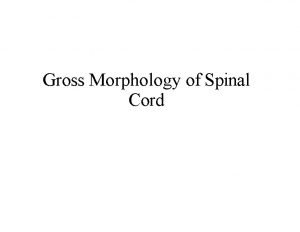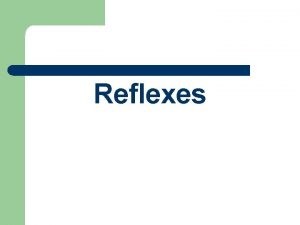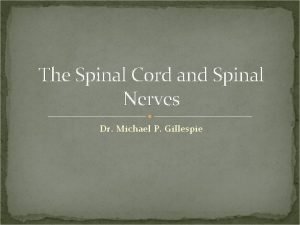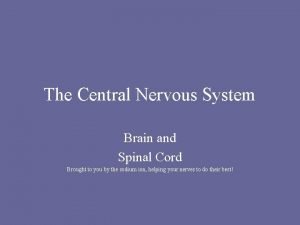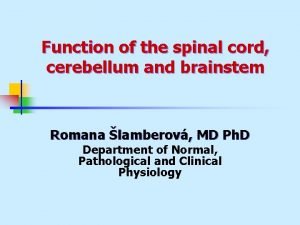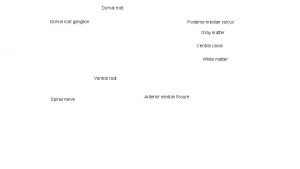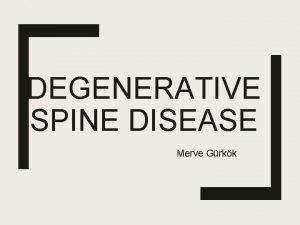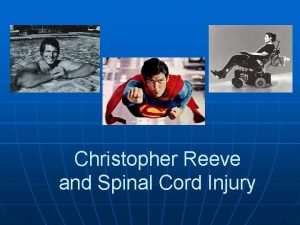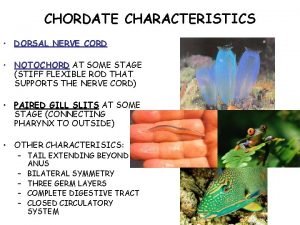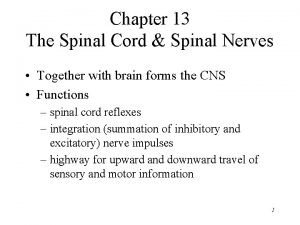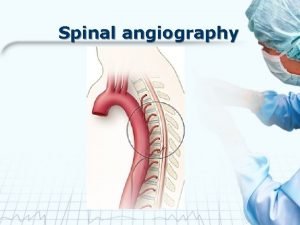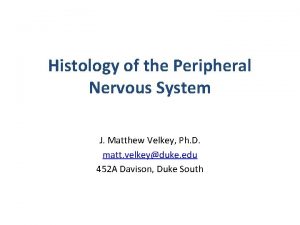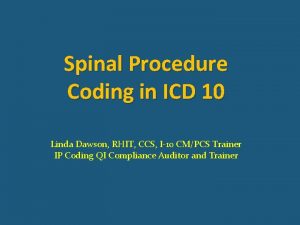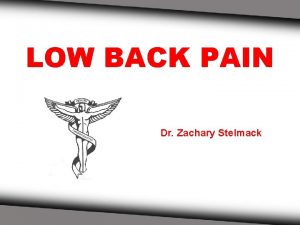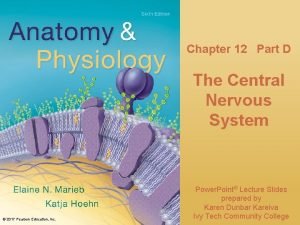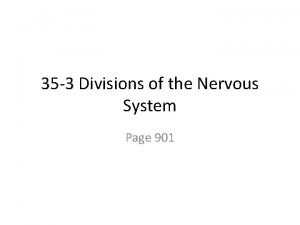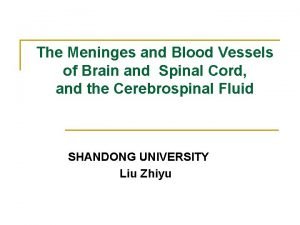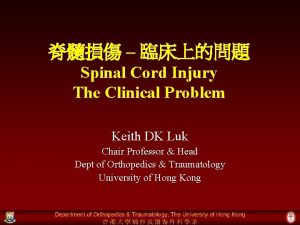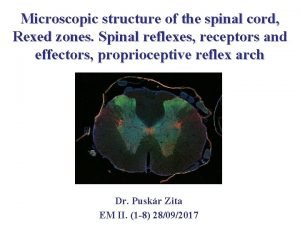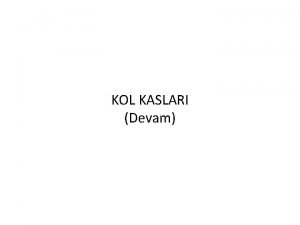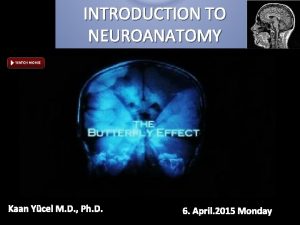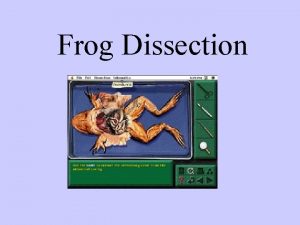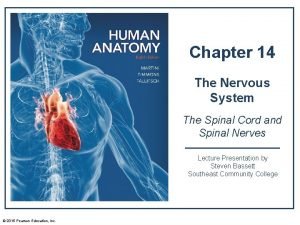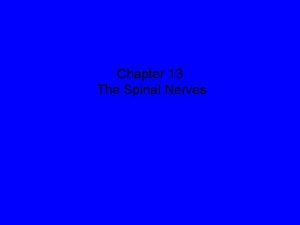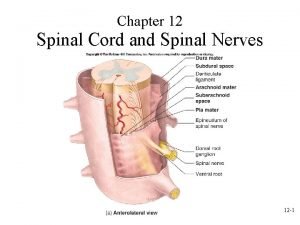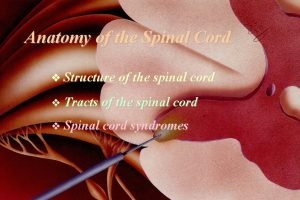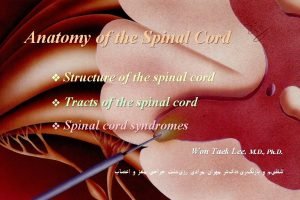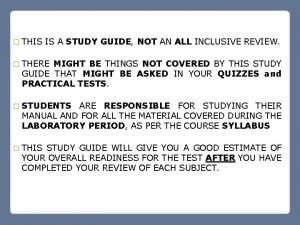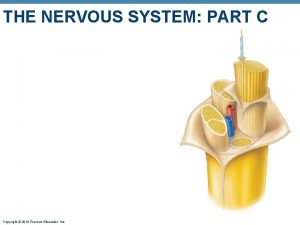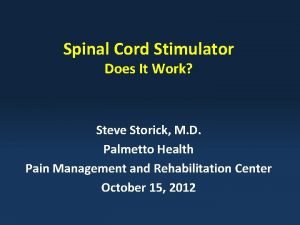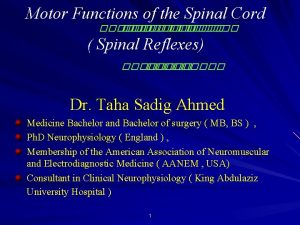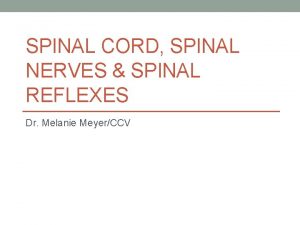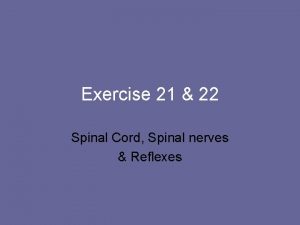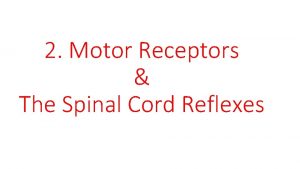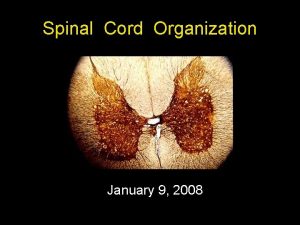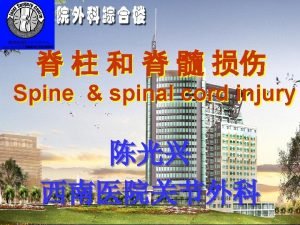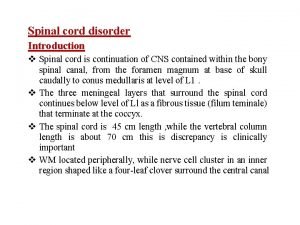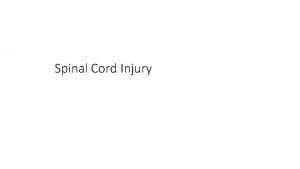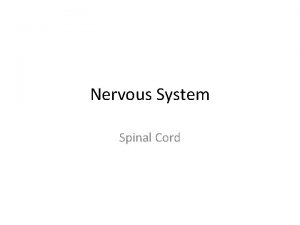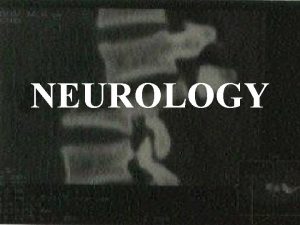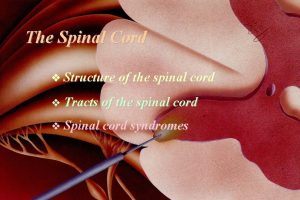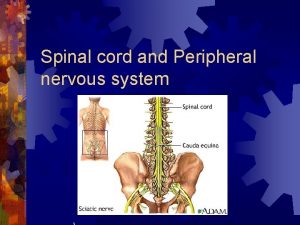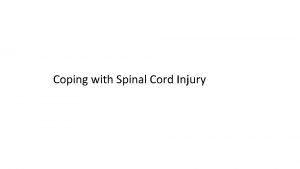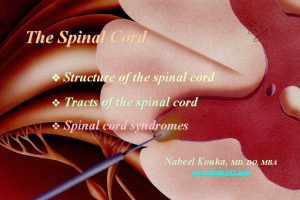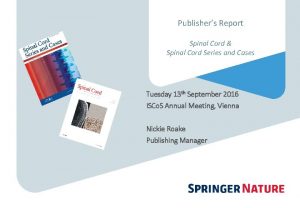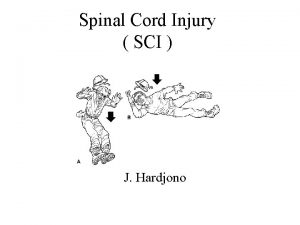Motor Functions of the Spinal Cord Spinal Reflexes























































- Slides: 55

Motor Functions of the Spinal Cord ������ /������ ( Spinal Reflexes) ��������� Dr. Taha Sadig Ahmed, MB, BS ( England ) , MAANEM ( USA) Consultant , Clinical Neurophysiology ( Saudi Council of Health Specialities ) Consultant , Clinical Neurophysiology ( King Abdulaziz University Hospital , Riyadh Associate Professor , College of medicine , Riyadh. 1


What is a spinal reflex ? A spinal reflex is an automatic , involuntary neuromuscular action elicited by a defined stimulus The basic unit of a reflex is the reflex arc. The controlling center of the spinal reflex is located in one or more spinal cord segments Receptor is Muscle Spindle 3

The Spinal Reflex Arc Consists of : 1. Sense organ (receptor). 2. Afferent ( sensory ) neuron. 3. Centre ( in spinal cord ) with one synapse in case of monosynaptic reflexes , and more than one synapse in case of polysynaptic reflexes ). 4. Efferent ( motor ) neuron. 5. Effector (muscle or gland ). 4

Afferent fiber DRG Efferent fiber 5

The Afferent Neurons (1) The afferent (sensory ) neuron is a pseudobipolar cell , having its cell-body in the dorsal root ganglion ( DRG). Its afferent fiber enters the spinal cord via the posterior spinal root , and : (1) In case of monosynaptic reflexes synapses directly on the anterior horn cell (2) in case of polysynaptic reflexes synapses on a posterior horn cell , which can be (a) at the same spinal segment where the afferent fiber entered the spinal cord , or (b) at an adjacent , higher or lower spinal segment ( after the afferent fiber ascends or descends for a few higher or lower spinal levels ). 6

The Afferent Neurons (2) In case of polysynaptic reflexes one or more interneurn will connect the posterior horn cell to the anterior horn cell. Afferent neurons can undergo: – Divergence to spread the effect of a single stimulus to more motoneurons in the same spinal segment , or to adjacent segments, – Convergence ( e. g. on a motoneuron ) to facilitate spatial summation. 7

The Interneurons (in case of Polysynaptic reflexes) Interneurons are small excitable cells in the grey matter of spinal cord , connecting posterior ( dorsal ) horn cells to the anterior horn cells. They can be single or multiple. Together , they may constitute local spinal circuits Some of them could be excitatory and others could be inhibitory. 8

The Efferent Neurons These are motor neurons ( motoneurons ). That are situated in the anterior horn of the spinal cord ( i. e. , they are anterior horn cells, AHCs): ü They are 2 types: (1) Large alpha motor neurons : Innervates the large extrafusal muscle fibers. ( Extrafusal fibers are the regular contractile units of the muscle , which constitute the muscle bulk , and which are responsible for the actual shortening of the muscle ). (2) Small gamma motor neurons : Innervate the intrafusal fibers. ( Intrafusal fibers are the tiny fibers that are present inside the muscle spindle , which is the muscle receptor ). ü ü 9

Muscle Receptor Alpha motor neuron to Extrafusal Fibers Gamma motor neuron to Intrafusal Fibers (inside the muscle spindle ) 10

Input to Alpha Motor Neurons 3 sources ﺛﻼﺛﺔ ﻣﺼﺎﺩﺭ 1. DRG neurons – sensory neurons (proprioception) 2. Upper motor neurons – primarily from M 1 (Cortical Motor Area)) 3. Spinal interneurons – Can be excitatory or inhibitory 11

There are 3 Inputs to Alpha Motor Neurons DRG (1) Afferent (sensory) neuron (2) Upper motor (3) Spinal interneurons 12

Important Definitions Reflex ( Response) Time = Time that elapses between application of the stimulus and appearance of the response. Minimal Synaptic delay ( time taken in one synapse) ~ 0. 5 ms. Central Delay : Time taken in spinal cord synapses Central Dealy = Total Reflex time –Time spent in conduction of impulses along the afferent and efferent nerves. Number of synapses = Central Delay /0. 5 ms 13


Classification of Reflexes According to the Number of Synapses Present in the Reflex Arc (1) Monosynaptic Reflexes ﺍﻟﻤﻨﻌﻜﺴﺎﺕ ﺃﺤﺎﺩﻳﺔ ﺍﻟﻤﺸﺒﻚ : have one synapse only : The sensory ( afferent ) axon synapse directly on the anterior horn cell. l. Therefore , the reflex arc does not contain interneurons. l. Examples : The Stretch ( Tendon ) reflexes ( also called Tendon Jerks ). l l Polysynaptic reflxes ﺍﻟﻤﻨﻌﻜﺴﺎﺕ ﻣﺘﻌﺪﺩﺓ ﺍﻟﻤﺸﺎﺑﻚ : Have more than one synapse , therefore contain interneuron(s). l. Examples : Abdominal Reflexes , withdarwal reflex , Plantar response. l 15

Stretch Reflexes are Monosynaptic 16

Monosynaptic Stretch Reflex l Postural adjustments ﺗﻈﺒﻴﻂ ﻭﺿﻌﻴﺔ ﺍﻟﺠﺴﻢ l Muscle tone l knee-jerk l Muscle reflex spindles l length detectors l Low threshold Ø Activity in afferent from muscle spindle leads to: ü 1) stimulation of extrafusal fibers in muscl ü 2) Reciprocal Inhibition of antagonist muscle 17

Classification of Reflexes According to the Location of the Receptor (1) Superficial Reflexes : The receptor is in the skin ( cutaneous receptor) e. g. , abdominal reflexes , plantar reflex , anal reflex. (2) Deep reflexes : The receptor is located in muscle or tendon e. g. , a) Stretch Reflexes (Tendon jerks ) : such as the biceps jerk , triceps jerk , knee-jerk ( patellar reflex ) , ankle jerk. The receptor for all these is called muscle spindle , and is located within the muscle itself. b) Inverse Stretch Reflex ( Golgi Tendon Organ reflex ) : The receptor is called Golgi Tendon Organ , and is present in the muscle tendon. 18

Classification of Reflexes According to the Location of the Receptor (2) (3) Visceral Reflexes ﻣﻨﻌﻜﺴﺎﺕ ﺣﺸﻮﻳﺔ : Reflexes involving the autonomic reflex arc , receptors are located in the viscera e. g. , micturition reflex ﺍﻟﻤﻨﻌﻜﺲ ﺍﻟﺒﻮﻟﻲ , Defecation reflex ﺍﻟﻤﻨﻌﻜﺲ ﺍﻟﺒﺮﺍﺯﻱ , erection reflex ﺍﻟﻤﻨﻌﻜﺲ ﺍﻷﻨﺘﺼﺎﺑﻲ. 19

The Muscle Spindle (1) ������ Each spindle consists of 3 -12 tiny ( small) muscle fibers , called Intrafusal Fibres. They lie parallel to the large Extrafusal Fibres ( which constitute the muscle bulk ) and are attached to them or to the tendon. Each intrafusal fibre consists of: – Central non-contractile area (receptor), – Peripheral contractile parts. 20

The Muscle Spindle (2) Types of Intrafusal Fibers There are two types of intrafusal fibers: – Nuclear bag fibers : contain many nuclei in a dilated central area ( “ bag ” ). Typically there are 2 nuclear bag fibers per spindle. – Nuclear chain fibers : thinner and shorter than nuclear bag fibers , and have one line of nuclei spread in a chain along the receptor area. There are 4 or more nuclear chain fibers per spindle ( 4 – 9 usually ) 21

The Muscle Spindle (3) Nuclear bag fiber Nuclear chain fiber 22

The muscle spindle(5) Sensory Innervation of the Muscle Spindle (2) B/ Secondary ( Flower-spray ) Afferents : 1. Innervate ONLY the nuclear chain receptor – Discharge at an increased rate throughout the period during which the muscle is being stretched, directly proportion to the degree of stretch (measure only muscle length). – This response is known as the Static Response – ﻷﻨﻬﺎ ﺗﺴﺠﻞ ﻓﻘﻂ ﺍﻟﺘﻐﻴﺮ ﺍﻟﻤﻄﻠﻖ ﻓﻲ ﺍﻟﻄﻮﻝ ﻭ ﻟﻜﻨﻬﺎ ﻻ ﺗﺴﺠﻞ ﺳﺮﻋﺔ ﺍﻟﺘﻐﻴﺮ ﻓﻲ ﻃﻮﻝ ﺍﻟﻌﻀﻞ Nuclear bag fibres are supplied by primary endings only responsible for the dynamic response ( e. g. in case of knee-jerk ) Nuclear chain fibres are supplied by both primary and secondary endings responsible mainly for the static response ( and to a much lesser extent , dynamic response ). 24

Motor innervations of the muscle spindle (1) Efferent fibres to spindle gamma motor neurons supply the peripheral contractile parts of the intrafusal muscle fibres and are of two functional types: – Dynamic gamma efferent end mainly on the nuclear bag fibres – Static gamma efferent end mainly on nuclear chain fibres 25

Mechanism of Action of the Stretch reflex Stretching the muscle bulk ( extrafusal fibers ) also stretches the receptor ( muscle spindle ) , because the muscle spindle intrafusal fibers lie in parallel with the extrafusal fibers of the muscle bulk. stretch receptor in intrfusal fibre stimulation of sensory endings. Afferent impulses go to spinal cord stimulate: 1. Alpha Motoneurons , which send impulses to Extrafusal Muscle Fibres contraction of the muscle bulk. 2. Gamma Efferent Motoneurons , which send motor impulses to the Intrafusal Fibers inside the muscle spindle leading to shortening of the peripheral contractile parts of the intrafusal fibres increase the sensitivity of the receptor to muscle stretch. 26

Dynamic Component of Stretch Reflex 1. ü ü ü Dynamic stretch reflex Sudden rapid stretch of a muscle stimulates the receptor which sends synchronous strong excitatory impulses from the primary ( annulospiral ) endings to the alpha motor neurons in the anterior horn of the spinal cord. The stimulated alpha motoneurons send excitatory impulses to the extrafusal fibers causing contraction of the muscle bulk this results in a jerky movement As the muscle shortens the spindle becomes lax – and ceases to discharge no more stimulation of alpha motoneuron no more excitatory impulses from alpha motoneuron to the extrafusal fibers muscle relaxes This is the basis of tendon jerks( stretch reflexes ). 27

Static Component of Stretch Reflex 2. Static stretch reflex – Maintained stretch of muscle – Impulses from muscle spindle travel through secondary sensory nerve to alpha motor neuron causing muscle contraction – Asynchronous discharge resulting in mild sustained contraction of muscle as long as it is stretched – Basis of muscle tone 28

Higher control on gamma efferent discharge (1) 1. Cortical areas. – The primary motor area (motor area 4) is facilitatory to gamma motor neurons. lesions of motor area 4 or pyramids in the medulla oblongata hypotonia. – Lesions of motor cortex, such as strokes (which damage both facilitatory and inhibitory areas), are characterized by hypertonia (spasticity). 29

Higher control on Gamma Efferent Discharge and hence on the Stretch Reflex and Muscle Tone (2) 2. Basal ganglia (BG) ( Extrapyramidal Areas ) – Generally ( in most instances ) Inhibitory to Gamma Efferents ( and consequently to the muscle tone and stretch reflex ). – Indirect effect ( there is no direct BG to spinal cord tract ). They exert their effect by stimulating a small area in the reticular formation of the brain stem (medullary reticular formation). The latter sends inhibitory impulses to gamma motor neurons via the lateral reticulospinal tracts. – Loss of BG inhibitory influence ( e. g. in Parkinson’s disease ) result in hypertonia muscle rigidity. 30

Higher control on Gamma Efferent Discharge and hence on the Stretch Reflex and Muscle Tone (3) 3. Brain stem. – Facilitatory Pontine reticular formation Vestibular nuclei – Inhibitory: Medullary reticular area carrying impulses from inhibitory cortical areas, basal ganglia and red nucleus. 31

Higher control on Gamma Efferent Discharge and hence on the Stretch Reflex and Muscle Tone (4) 4. The cerebellum. – Cerebellar cortex exerts an inhibitory influence on the stretch reflex. – Deep cerebellar nuclei (DCN) are excitatory via lateral vestibular nuclei. – Cerebellar lesions in humans characterized by hypotonia, due to deep cerebellar nuclei lesion, 32

Summary of Factors Controlling /Regulating/Influencing the Stretch Reflex Enhances ( )ﺗﺰﻳﺪ ﻣﻦ ﻧﺸﺎﻃﻬﺎ Inhibits A/ Supraspinal influences : 1. Cortical : (a) Primary motor area (b) Corical/limbic : fear/apprehension , and anxiety , pain 2. Brainstem : (a) Vestibular nuclei (b) Pontine centers 3. Cerebellum B/ Largely spinal mechanisms : related to noxious ( painful) stimuli. A/Supraspinal : Cortical ( voluntary , conscious , mostly). 2. Extrapyramidal (Basal ganglia , Red Nucleus ). 3. Brainstem : (a) Medulla. (b) Reticular formation. 4, Cerebellum B/ Largely spinal mechanisms : 1. Excessive muscle stretch ( stimulation of Golgi tendon organ ). 2. Muscle contraction 33

The Golgi tendon reflex (inverse stretch reflex) Inverse stretch reflex: excessive tension on the muscle (passive stretch of tendon or active muscle contraction) >> muscle relaxes opposite response to stretch reflex. The receptors are Golgi tendon organs in muscle tendons stimulated >> muscle contract and pulled on the tendon (tension) stimulate golgi organ>> A fibers > spinal cord > excitation of inhibitory interneuron>> inhibit alpha motor neuron > muscle relaxation Protect muscle from rupture 34

The Golgi tendon reflex (inverse stretch reflex) 35

Withdrawal reflex (1) (flexor reflex/respnse) Stimulation of pain receptors in a limb ( e. g. , hand or foot )>> impulses to spinal cord via A or C fibres >> interneurons >> anterior horn cells >> stimulate hand flexor muscles >>move the hand away from the injurious stimulus. a polysynaptic reflexe. stimulation of flexors muscle accompanied by inhibition of extensors. Inhibitory inter neurons synapse with extensor motor neurons known as reciprocal innervations (reciprocal inhibition). 36

Withdrawal reflex (2) Flexion and withdrawal of the stimulated limb >> extension of the opposite limb >> occurs with strong stimulus (crossed extensor reflex) Reciprocal innervations occurs in extensor reflex >> flexors are inhibited while extensors are excited >> pushes the entire body away from the injurious agent and supports the body weight. Withdrawal reflex is characterized by after discharge, which prolongs the response and further enhances the protective role of the reflex. 37

Properties of reflexes 1. Adequate stimulus – Each reflex has a precise stimulus called the adequate stimulus. For example, a painful stimulus to the sole of the foot produces the flexor withdrawal reflex, while deep pressure applied to the same area produces the positive supportive reaction. 38

Properties of Reflexes 2. Irradiation and recruitment ( spatial ): – – – The extent of the response in a reflex depends on the intensity of the stimulus. The more intense the stimulus is, the greater is the spread of activity in the spinal cord, involving and recruiting more and more other motor neurons. when the sole of the foot is stimulated by a weak painful stimulus, only the big toe is flexed. A stronger stimulus will cause reflexion of the big toe , other toes , plus the ankle. The strongest stimulus will cause withdrawal of the whole leg by causing reflexion of the big toe, ankle, knee and hip. Impulses may also cross to the other side of the spinal cord to cause extension of the other leg. 39

Properties of reflexes 3. Summation – A/ In spatial summation: two or more stimuli, through different sensory routes, which by themselves are insufficient to elicit a reflex contraction, may elicit a contraction when given together. Summation of subliminal fringes – – – The tension obtained in a certain reflex by weak (but threshold) stimulation of two adjacent afferents simultaneously is more than the sum of tension developed when each is stimulated separately. Stimulation of each afferent separately causes discharge of some neurons but only facilitates some nearby neurons (excites them but not enough to discharge). Those facilitated neurons are said to lie in the subliminal fringe zone of those discharging. 40

Spatial Facilitation ( Spatial Summation ) Input A Input B 41

(1) If neuron B fires, neuron X is excited to threshold and fires AP (4) Neuron Y is in Subliminal Fringe Zone. If BOTH B and C fire at the same time Y threshold of is reached it fires AP (3) If B alone OR C alone fire , they only increase excitability of neurons in the area within the square (called Subliminal Fringe zone ) , but membranes of neurons in Subliminal Fringe zone t do not reach the firing level to fire. (2) If neuron c fires, neuron z is excited to threshold and fires AP 42

Summation ( continued ) – Simultaneous stimulation of the two afferents causes overlapping of the subliminal fringe zones and raises the excitability of the neurons (within the subliminal zones) to discharge. – B/ In temporal summation: – two or more stimuli given at different times, which by themselves are insufficient to elicit a reflex contraction, may elicit a contraction if given within a short time of each other (15 ms). Temporal Summation 43

Properties of reflexes 4. Recruitment and after-discharge – – If a repetitive stimulus is maintained, the strength of the reflex contraction slowly increases to a final level. The slow build-up is due to gradual activation of more motor neurons (recruitment , temporal ). The reflex response may continue some time after cessation of the stimulus, due to afterdischarge, the main type being reverberating circuit after-discharge. 44

5. Reverberating circuits impulse from one neuron feed back to restimulate itself for long time, this (1) prolongs the response so that it outlives the stimulus for a considerable time. (2) augments ( reinforces ) the response. It eventually stops or wanes out due to fatigue or due to inhibitory impulses from other parts of CNS with inhibitory interneurons. 45

Reverberating circus 46

Properties of reflexes 6. Reciprocal innervation or reciprocal inhibition – Reflex contraction of an agonist muscle is accompanied by inhibition of the antagonist. – When the biceps is involved in a stretch reflex, the triceps must relax or no movement will occur. – This is a reciprocal inhibition >> impulses enter the spinal cord will stimulate the motor neurons supplying the stimulated muscle an inhibitory interneuron >> inhibiting motor neurons supplying the antagonist muscle. 47

48

7. The Renshaw cell Is located in anterior horn in close association with motor neurons. it is an inhibitory cell excited by collaterals from an alpha motor neuron to project back and inhibit the same motor neuron (negative feedback fashion). 49

50

Properties of reflexes 8. Response time – Response time is an indicator of the number of synapses in the reflex arc. Very short response times indicate a smaller number of synapses in reflex path. – The knee-jerk, which has the shortest response time, is a monosynaptic reflex. 51

Properties of reflexes 9. Rebound phenomenon – – This is the exaggeration of a reflex after a temporary period of inhibition. For example, a flexor withdrawal reflex in one limb involves stimulation of flexors and inhibition of extensors. If this is followed by another reflex which involves stimulation of extensors of the same limb the extensor response will be greatly exaggerated. Rebound is one of the important mechanisms for coordinating the rhythmic to and from movement required in walking and running. 52

10. One Spinal Common Output for Motor Activity ( Final Common Pathway ) – Many sensory inputs and interneurons converge on the motor neuron, because motor neurons are the only efferent pathways from the spinal cord. – – – Movement is the result of contraction of skeletal muscle stimulated by motor neurons , which are the final common efferent pathway through which all spinal and supraspinal inputs must converge & pass to influence muscle activity. Each lower motor neuron ( motoneuron ) controls a group of muscle fibers. The name given to a single motor neuron and all the muscle fibers it controls is “ Motor Unit ’’ ( remember Nerve & muscle course ). In the spinal cord motoneurons are arranged in 2 groups : medial and lateral : The medial group innervate (1) trunk muscles (2) muscles of the proximal parts of the limbs thereby controlling posture and gross movements The lateral group innervate muscles of the most distal parts of the limbs concerned with fine skilled movements. 53

Convergence of many neurons the Final common Pathway ( Anterior Horn Cell ) 54

Centers of Some Deep Reflexes Biceps Spinal center C 5 -C 6 Triceps C 6 -C 7 Knee L 2, L 3, L 4 Ankle S 1, S 2 55

Centers of some Superficial and Visceral Reflexes Superficial & visceral reflexes Corneal Centers Pons Upper abdominal T 8 - T 10 Lower abdominal T 10 - T 12 Planter L 5 - S 1 Anal S 3 - S 4 Micturation ( visceral ) S 2, S 3, S 4 Defecation ( visceral ) S 2, S 3, S 4 56
 Spinal nerves labeled
Spinal nerves labeled Spine meninges
Spine meninges Spinal cord anatomy
Spinal cord anatomy Cervical and brachial plexus
Cervical and brachial plexus Lumbar puncture introduction
Lumbar puncture introduction Definition of reflex action
Definition of reflex action Spinal cord denticulate ligament
Spinal cord denticulate ligament Nervous sysytem
Nervous sysytem Hyporeflexia and hyperreflexia
Hyporeflexia and hyperreflexia Spinal cord tumors
Spinal cord tumors Extrapyramidal tract
Extrapyramidal tract Dorsal root ganglion
Dorsal root ganglion Scottie dog lumbar spine
Scottie dog lumbar spine Christopher reeve spinal cord injury level
Christopher reeve spinal cord injury level Bird air sac
Bird air sac Perineurium
Perineurium Lateral horn of spinal cord function
Lateral horn of spinal cord function Spinal cord organization
Spinal cord organization 3 layers of spinal cord
3 layers of spinal cord Tethered cord
Tethered cord Somatic nervous system
Somatic nervous system Spinal arteries
Spinal arteries Dermatome map
Dermatome map Spinal cord
Spinal cord Spinal cord
Spinal cord Tissue
Tissue Eat well live well
Eat well live well Icd 10 code for lumbar laminectomy with fusion
Icd 10 code for lumbar laminectomy with fusion Intensivis
Intensivis Low back rom
Low back rom Spinal cord cross section
Spinal cord cross section Spinal cord and brain
Spinal cord and brain Meninges
Meninges Christopher reeve ventilator
Christopher reeve ventilator The tapered conical portion of the spinal cord is the
The tapered conical portion of the spinal cord is the Spinal cord injury shoulder exercises
Spinal cord injury shoulder exercises Mechanoreceptor
Mechanoreceptor Brachioradialis
Brachioradialis Ventral root and dorsal root
Ventral root and dorsal root Latin meaning of phylum and class
Latin meaning of phylum and class Pyramidal system
Pyramidal system Connective tissue layer
Connective tissue layer Spinal cord nerve anatomy
Spinal cord nerve anatomy Spinal cord anterior
Spinal cord anterior Functional unit of nervous system
Functional unit of nervous system Spinal cord
Spinal cord Spinal cord
Spinal cord Gray matter
Gray matter Site of somatic motor neuron cell bodies
Site of somatic motor neuron cell bodies Nervous system objectives
Nervous system objectives Cervical nervous system
Cervical nervous system Boston scientific spinal cord stimulator
Boston scientific spinal cord stimulator Gray commisure
Gray commisure Spinal cord injury rehabilitation st. louis
Spinal cord injury rehabilitation st. louis Spinal cord
Spinal cord Partes
Partes




